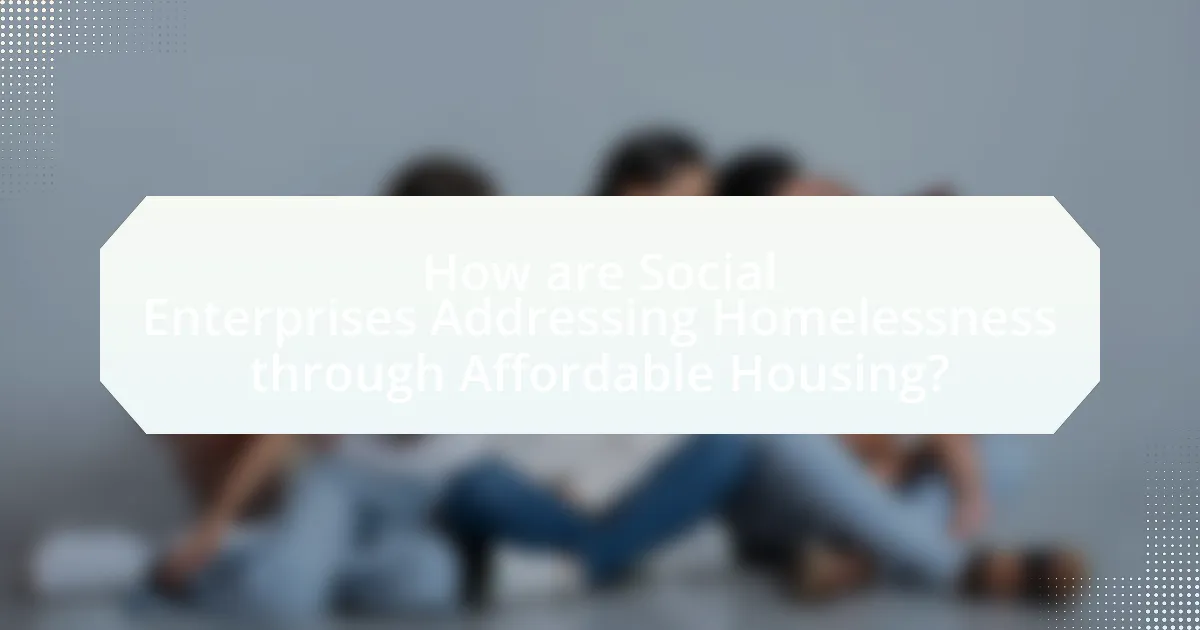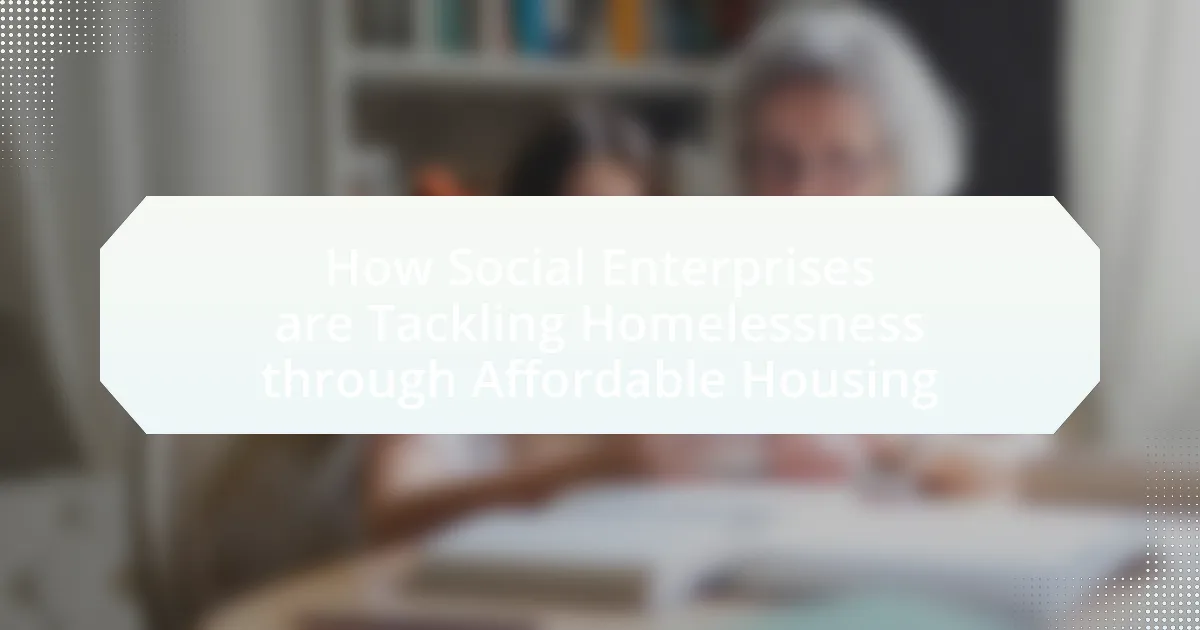Social enterprises are increasingly recognized for their role in addressing homelessness through the provision of affordable housing. These organizations develop and manage low-cost housing solutions while integrating supportive services such as job training and mental health support, which enhance the stability of residents. By employing innovative funding models and collaborating with local governments, social enterprises create sustainable housing initiatives that not only alleviate immediate housing needs but also tackle the root causes of homelessness. The article explores the strategies, challenges, and impacts of social enterprises in the housing sector, highlighting their effectiveness in reducing homelessness rates and fostering community development.

How are Social Enterprises Addressing Homelessness through Affordable Housing?
Social enterprises are addressing homelessness through affordable housing by developing and managing low-cost housing solutions that prioritize the needs of vulnerable populations. These organizations often leverage innovative funding models, such as social impact bonds and community investment funds, to finance the construction and maintenance of affordable units. For instance, in the United States, the nonprofit organization Habitat for Humanity has built over 1 million homes, providing affordable housing to families in need, which directly contributes to reducing homelessness. Additionally, social enterprises frequently collaborate with local governments and community stakeholders to create supportive housing initiatives that integrate services like job training and mental health support, further enhancing the stability of residents. This multifaceted approach not only provides shelter but also fosters long-term solutions to homelessness.
What role do social enterprises play in combating homelessness?
Social enterprises play a crucial role in combating homelessness by providing innovative solutions that address both immediate needs and long-term stability. These organizations often focus on creating affordable housing options, which directly contribute to reducing homelessness rates. For instance, social enterprises like Habitat for Humanity have built over 1 million homes globally, offering low-income families access to affordable housing and fostering community development. Additionally, social enterprises frequently integrate support services, such as job training and mental health resources, which help individuals transition out of homelessness and into sustainable living situations. This multifaceted approach not only alleviates the symptoms of homelessness but also tackles its root causes, demonstrating the effectiveness of social enterprises in this critical area.
How do social enterprises differ from traditional housing initiatives?
Social enterprises differ from traditional housing initiatives primarily in their dual focus on social impact and financial sustainability. While traditional housing initiatives often prioritize the provision of affordable housing through government funding or non-profit models, social enterprises operate with a business-oriented approach that generates revenue to support their social missions. For instance, social enterprises may engage in property management or construction services to fund their housing projects, thereby creating a self-sustaining model that can adapt to changing economic conditions. This approach not only addresses housing needs but also empowers communities by creating jobs and fostering local economic development.
What are the key strategies employed by social enterprises in this context?
Social enterprises tackling homelessness through affordable housing employ key strategies such as community engagement, innovative financing, and partnerships with local governments. Community engagement involves actively involving residents in the planning and decision-making processes, ensuring that housing solutions meet their needs. Innovative financing strategies, such as social impact bonds and crowdfunding, provide necessary capital while minimizing reliance on traditional funding sources. Partnerships with local governments enhance resource sharing and facilitate access to land and regulatory support, which are crucial for developing affordable housing projects. These strategies collectively enable social enterprises to create sustainable housing solutions that effectively address homelessness.
Why is affordable housing crucial in tackling homelessness?
Affordable housing is crucial in tackling homelessness because it provides individuals and families with stable living conditions, which are essential for achieving self-sufficiency. Research indicates that when people have access to affordable housing, they are more likely to secure employment, maintain health, and improve their overall quality of life. For instance, a study by the National Low Income Housing Coalition found that for every 100 extremely low-income households, there are only 30 affordable rental units available, highlighting the severe shortage that contributes to homelessness. By increasing the availability of affordable housing, social enterprises can effectively reduce the number of individuals experiencing homelessness and promote long-term stability within communities.
What are the economic impacts of affordable housing on communities?
Affordable housing positively impacts communities by stimulating local economies and enhancing social stability. When affordable housing is available, it increases disposable income for low-income families, allowing them to spend more on local goods and services, which in turn boosts local businesses. For instance, a study by the National Low Income Housing Coalition found that for every $1 invested in affordable housing, there is a return of approximately $1.50 in economic activity. Additionally, affordable housing reduces homelessness and housing instability, leading to lower public costs associated with emergency services and healthcare. This creates a more stable community environment, which attracts further investment and development.
How does affordable housing contribute to social stability?
Affordable housing contributes to social stability by providing individuals and families with secure living conditions, which fosters community cohesion and reduces displacement. When people have access to affordable housing, they are more likely to invest in their neighborhoods, participate in local activities, and build social networks. Research indicates that stable housing leads to improved mental health and educational outcomes, as families can focus on long-term goals rather than the stress of housing insecurity. For instance, a study by the Urban Institute found that stable housing reduces the likelihood of eviction and homelessness, which are significant factors in social instability.
What challenges do social enterprises face in providing affordable housing?
Social enterprises face significant challenges in providing affordable housing, primarily due to limited funding and regulatory barriers. These organizations often struggle to secure sufficient financial resources, as traditional funding sources may prioritize profit-driven ventures over social impact initiatives. Additionally, navigating complex zoning laws and building regulations can hinder their ability to develop housing projects efficiently. For instance, a report by the National Alliance to End Homelessness highlights that social enterprises frequently encounter delays and increased costs due to bureaucratic processes, which can impede their mission to deliver affordable housing solutions.
How do funding and resource limitations affect their operations?
Funding and resource limitations significantly hinder the operations of social enterprises addressing homelessness through affordable housing. These constraints restrict their ability to secure necessary materials, hire skilled labor, and implement comprehensive programs, ultimately reducing the scale and effectiveness of their initiatives. For instance, a study by the National Alliance to End Homelessness indicates that inadequate funding can lead to a 30% decrease in the number of housing units developed by social enterprises, directly impacting their capacity to provide shelter for vulnerable populations.
What regulatory hurdles must social enterprises navigate?
Social enterprises must navigate various regulatory hurdles, including compliance with zoning laws, tax regulations, and funding restrictions. Zoning laws can limit where affordable housing projects can be developed, impacting the availability of suitable locations. Tax regulations often dictate the financial structures that social enterprises can utilize, such as tax credits or exemptions, which can affect their funding and sustainability. Additionally, funding restrictions from government or private sources may impose specific requirements on how funds can be used, complicating the operational flexibility of social enterprises. These regulatory challenges can hinder the ability of social enterprises to effectively address homelessness through affordable housing initiatives.
How do social enterprises collaborate with local governments and communities?
Social enterprises collaborate with local governments and communities by forming partnerships that leverage resources, expertise, and networks to address social issues, including homelessness. These collaborations often involve joint initiatives, such as developing affordable housing projects, where social enterprises provide innovative solutions and local governments offer regulatory support and funding. For example, in cities like San Francisco, social enterprises have worked with local authorities to create supportive housing models that integrate services for the homeless, demonstrating the effectiveness of such partnerships in tackling homelessness through affordable housing solutions.
What innovative models are being used by social enterprises for affordable housing?
Social enterprises are utilizing innovative models such as community land trusts, cooperative housing, and modular construction to provide affordable housing. Community land trusts enable communities to collectively own land, ensuring long-term affordability and preventing displacement. Cooperative housing allows residents to have a stake in their living environment, fostering community engagement and shared responsibility. Modular construction, which involves prefabricating building sections off-site, reduces costs and construction time, making housing more accessible. These models have been shown to effectively address housing shortages and promote sustainable living environments.

What are the impacts of social enterprises on homelessness rates?
Social enterprises significantly reduce homelessness rates by providing affordable housing solutions and supportive services. These organizations often focus on creating sustainable housing options, which directly addresses the lack of affordable living spaces that contribute to homelessness. For instance, a study by the National Alliance to End Homelessness found that social enterprises that develop affordable housing can decrease homelessness by up to 30% in targeted areas. Additionally, social enterprises frequently offer job training and employment opportunities, which help individuals experiencing homelessness gain financial stability, further reducing the likelihood of returning to homelessness.
How do social enterprises measure their success in reducing homelessness?
Social enterprises measure their success in reducing homelessness primarily through metrics such as the number of individuals transitioned into stable housing, the duration of housing retention, and improvements in clients’ overall well-being. For instance, organizations often track the percentage of participants who maintain their housing for a specified period, typically six months to a year, which serves as a key indicator of program effectiveness. Additionally, qualitative assessments, including client satisfaction surveys and follow-up interviews, provide insights into the social and economic impacts of housing stability on individuals’ lives. Data from studies, such as those conducted by the National Alliance to End Homelessness, indicate that successful housing-first models can reduce homelessness by up to 80%, demonstrating the effectiveness of these measurement strategies.
What metrics are used to evaluate the effectiveness of affordable housing initiatives?
Metrics used to evaluate the effectiveness of affordable housing initiatives include housing stability, affordability, and resident satisfaction. Housing stability is measured by the percentage of residents who remain in their homes over time, indicating the initiative’s success in providing long-term solutions. Affordability is assessed through the proportion of income that residents spend on housing costs, ideally keeping it below 30%. Resident satisfaction is gauged through surveys that capture the quality of life and community engagement among residents. These metrics collectively provide a comprehensive view of how well affordable housing initiatives meet their goals and impact the lives of individuals and families.
How do success stories from social enterprises influence public policy?
Success stories from social enterprises significantly influence public policy by demonstrating effective solutions to social issues, such as homelessness. These narratives provide concrete examples of how innovative approaches can lead to successful outcomes, prompting policymakers to consider similar strategies in their legislative frameworks. For instance, the success of social enterprises in creating affordable housing has led to increased funding and support for similar initiatives, as seen in cities that have adopted policies encouraging public-private partnerships to address housing shortages. This evidence-based approach helps to shift public perception and encourages government entities to allocate resources towards proven models that effectively tackle homelessness.
What are the long-term benefits of social enterprises in the housing sector?
Social enterprises in the housing sector provide long-term benefits such as increased access to affordable housing, community empowerment, and sustainable development. These organizations often prioritize social impact over profit, leading to innovative housing solutions that address the needs of low-income populations. For instance, a study by the National Housing Federation found that social enterprises can reduce homelessness rates by creating stable housing options, which in turn fosters community stability and economic growth. Additionally, social enterprises frequently reinvest profits into local communities, enhancing social infrastructure and promoting long-term resilience against housing crises.
How do these benefits extend beyond just housing solutions?
The benefits of affordable housing solutions extend beyond mere shelter by fostering community stability, economic growth, and improved health outcomes. When individuals have access to stable housing, they are more likely to secure employment, which contributes to local economies; for instance, studies show that stable housing can increase employment rates by up to 20%. Additionally, affordable housing reduces healthcare costs, as individuals in stable living conditions experience fewer health issues, leading to a decrease in emergency room visits by approximately 30%. Furthermore, these housing solutions promote social cohesion, as stable communities often see lower crime rates and enhanced civic engagement, creating a more supportive environment for all residents.
What role do social enterprises play in community development?
Social enterprises play a crucial role in community development by addressing social issues while promoting economic sustainability. They create job opportunities, provide essential services, and foster community engagement, which collectively contribute to the overall well-being of the community. For instance, social enterprises focused on affordable housing not only offer shelter but also empower residents through skills training and employment, thereby reducing homelessness. According to a report by the Stanford Social Innovation Review, social enterprises can generate up to 50% more jobs in underserved areas compared to traditional businesses, highlighting their impact on local economies and community resilience.

What can be learned from successful social enterprises tackling homelessness?
Successful social enterprises tackling homelessness demonstrate the effectiveness of integrating affordable housing solutions with supportive services. These enterprises often provide not only housing but also job training, mental health support, and community engagement, which address the root causes of homelessness. For instance, the success of the nonprofit organization Homeward Bound in North Carolina shows that providing stable housing combined with comprehensive support services can lead to a 90% success rate in keeping individuals housed long-term. This model highlights the importance of a holistic approach, emphasizing that addressing homelessness requires more than just providing shelter; it necessitates a multifaceted strategy that includes economic empowerment and social integration.
What best practices can be identified from successful case studies?
Best practices identified from successful case studies in social enterprises tackling homelessness through affordable housing include community engagement, sustainable funding models, and collaborative partnerships. Community engagement ensures that the needs and preferences of homeless individuals are prioritized, leading to more effective housing solutions. For instance, the Community Solutions initiative has demonstrated that involving local residents in decision-making processes significantly improves project outcomes. Sustainable funding models, such as social impact bonds, have been shown to provide reliable financial support for long-term housing projects, as evidenced by the success of the New York City’s Home-Stat program, which allocated funds based on measurable outcomes. Collaborative partnerships between government agencies, non-profits, and private sector stakeholders enhance resource sharing and innovation, as seen in the partnership between the Corporation for Supportive Housing and various municipalities, which has led to the development of thousands of supportive housing units. These practices collectively contribute to the effectiveness of social enterprises in addressing homelessness through affordable housing solutions.
How can these practices be replicated in other communities?
Social enterprises can replicate practices that tackle homelessness through affordable housing by establishing partnerships with local governments, nonprofits, and community stakeholders to create tailored housing solutions. For instance, successful models like the Community Land Trusts in Burlington, Vermont, demonstrate how community ownership of land can provide long-term affordable housing options. Additionally, implementing funding strategies such as social impact bonds can attract private investment to support these initiatives, as evidenced by the success of the “Pay for Success” model in various U.S. cities. By adapting these proven strategies to local contexts, communities can effectively address homelessness through sustainable affordable housing solutions.
What common pitfalls should new social enterprises avoid?
New social enterprises should avoid the common pitfalls of inadequate market research, insufficient funding, and lack of clear social impact measurement. Inadequate market research can lead to misalignment with community needs, resulting in ineffective solutions. Insufficient funding often hampers operational sustainability, as many social enterprises rely on grants and donations that may not be consistent. Additionally, a lack of clear social impact measurement can prevent enterprises from demonstrating their effectiveness, making it difficult to attract further investment or support. These pitfalls are critical to address, as studies show that 70% of social enterprises fail due to these issues, highlighting the importance of strategic planning and evaluation in achieving long-term success.
What resources are available for social enterprises focused on affordable housing?
Social enterprises focused on affordable housing can access various resources, including grants, funding programs, and partnerships with government and nonprofit organizations. For instance, the U.S. Department of Housing and Urban Development (HUD) offers Community Development Block Grants (CDBG) that support affordable housing initiatives. Additionally, organizations like the Low Income Investment Fund (LIIF) provide financial resources specifically aimed at affordable housing projects. Furthermore, social enterprises can collaborate with local governments and community development financial institutions (CDFIs) to leverage additional funding and technical assistance. These resources are essential for enabling social enterprises to effectively address the affordable housing crisis and contribute to reducing homelessness.
How can individuals support social enterprises in their mission to tackle homelessness?
Individuals can support social enterprises in their mission to tackle homelessness by donating funds, volunteering time, and advocating for policies that promote affordable housing. Financial contributions provide essential resources for social enterprises to develop and maintain housing projects, while volunteering helps to build community and raise awareness about homelessness. Advocacy efforts can influence local government decisions, leading to increased support for affordable housing initiatives. According to the National Alliance to End Homelessness, effective advocacy can result in significant policy changes that benefit those experiencing homelessness, demonstrating the impact individuals can have in supporting these enterprises.

Leave a Reply